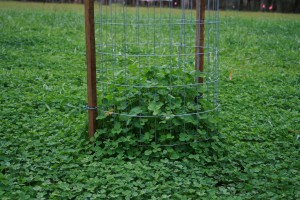
Exclusion cages help us determine how much forage is being produced and consumed. (photo by Jennifer Bearden)
It’s time to start planning your cool season wildlife food plots. Cool season food plots do a great job attracting deer and other wildlife to your property as well as providing a little nutrition. The first step is to choose an appropriate location. Remember wildlife like to stay close to cover but plants also need sunlight. Cool season food plots are generally smaller than warm season food plots (about an acre or so is sufficient). Once you find a suitable location, have your soil tested. Soil test results give you important information like pH, phosphorus levels and potassium levels. In August, perform your soil test so you have more time to adjust your pH. Adjust pH if necessary with lime applications. Cool season forage options include:
- Legumes – arrowleaf clover, crimson clover, ball clover, red clover, white clover, vetch and winter peas to name a few.
- Grasses – ryegrass, oats, wheat, rye, and triticale (a man made cross of wheat and rye).
- Brassicas like kale, turnips and tillage radish
- Forage Chicory
Legumes need to be inoculated with a rhizobium bacteria prior to planting. This will allow the plant to manufacture nitrogen and eliminate the need for extra nitrogen application. The pH range for most of these plants will between 5.5-7.0 but some clovers need a higher pH. I would recommend planting a mixture of these forages. One mixture that had a lot of success in our research plots in Quincy included arrowleaf clover, red clover, crimson clover, white clover, buck forage oats and tillage radish. The target pH for that mixture would be 6.0.
Cool Season Food Plot publication: A Walk on the Wild Side: 2013 Cool Season Forage Recommendations for Wildlife Food Plots in North Florida
- Have a Safe and Legal Hunting Season - November 10, 2025
- Killer Turkey Food Plot - January 31, 2025
- Common Wildlife Food Plot Mistakes - November 8, 2024
